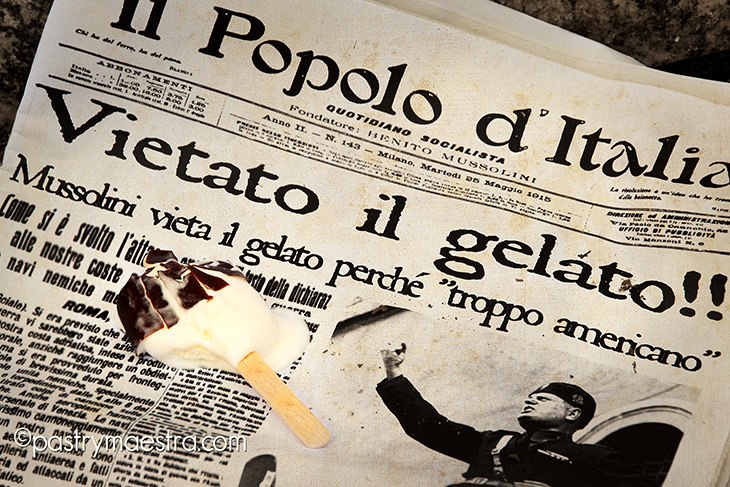
C
an you believe that the humble, simple ice cream can be a weapon of war? And not just any war – the second big one, no less! Well, Mussolini thought so, and apparently, the result was devastating – ice cream was allegedly officially banned in WWII Italy! Why? Because – “It was too American”, Mussolini supposedly said! Brrr, imagine the world without ice cream, now – that is a chilling thought, right? Anyway, the Allies won (thankfully) so we can get to work! Naturally, I am not a history teacher, so you should take this story “with a grain of sugar”, haha! Anyway, let’s learn about ice cream!
So…you have tested a zillion ice cream recipes, but your home made ice cream is still full of ice crystals? Annoying, right? Well, there is no secret – you need to stir your ice cream or sorbet mixture constantly! Stirring breaks crystals, but it also adds air to the mixture and makes it lighter. So no, unfortunately, you cannot make proper ice cream without the ice cream machine. Or can you?
What is Ice Cream?
The term ice cream is used to describe almost any dairy-based frozen dessert. However, it seems that the terminology depends on the law in each country. For example, according to the USDA (United States Department of Agriculture), ice cream is made of cream, milk, sweeteners, flavorings, stabilizers, and emulsifiers (for example – egg yolks). The milk content should be between 10% and 16%. By the EU legislations, ice cream is an emulsion typically composed of water and/or milk, edible fats, proteins and sugars, while dairy ice cream is a product containing at least 5% dairy fat, excluding any fat and/or protein other than of dairy origin.
Ice cream (or Italian gelato), in a traditional meaning, is a frozen dessert based on crème anglaise that can be made of milk, a combination of milk and cream or just cream, egg yolks, and sugar. The higher the fat content is (more cream and egg yolks), denser and less aerated ice cream is going to be. A variety of flavors can be added to crème anglaise before freezing: chocolate, nut pastes, fruit purees and various liqueurs. Chopped nuts, chocolate chips or fresh fruit are added after churning. To improve the texture and freezing abilities, stabilizers like gelatin, pectin, carrageenan (polysaccharide extracted from red edible seaweeds) can be added into ice creams.
No matter what flavor of ice cream you are making, it is of great importance to properly cool the ice cream base before freezing. It is recommended to leave the base in the refrigerator for 24 h before churning, so smooth and velvety texture is achieved.
Short History of Ice Cream
Despite various arguments, it is impossible to specify one country as an ice cream inventor. It was, most probably, invented in few countries at the same time, so we can safely say that China, Mediterranean, Middle East and Greece were the regions where this tasty treat originated from.
Alexander the Great enjoyed in wine flavored ice and controversial Roman emperor Neron’s feasts were usually crowned with the mixture of fruits, honey and crushed snow, brought from the tops of the mountains by his slaves. One would think that Italians developed their famous gelato from this concoction, but no – it was Marco Polo who allegedly brought the gelato recipe from China (!) in the 13th century! Go figure!
Ice cream became publicly available in 17th-century Parisian fashionable coffee shops, along with another new treat – coffee. However, this refreshing delicacy was still a privilege of the rich since it was difficult to find and store ice without electricity.
The ice cream machine was invented in 1846, and that had made the foundation for the mass production of the ice cream that we have today. In the 20th century, after cheap refrigeration became available, ice cream became popular throughout the world.
Ice Cream vs. Gelato
Gelato is an Italian name for ice cream, and strangely, there are no required specific standards in order to make it! In fact, you could make any ice cream and call it a gelato! In Italy, ice cream is made of milk, or combination of milk and cream, or a combination of milk, cream and egg yolks. The difference is in aeration or so-called “overrun”. Overrun is the percentage of the increase in volume between the ice cream base and the finished product. What does this mean? Well, if you have 1 liter (2 pints) of ice cream base and after churning you ended up with 1.5 liters (3 pints) of ice cream, the volume of the base increased by 50%. That means that you have overrun of 50%. So let’s get back to our gelato. The most ice creams have an overrun between 40% and 60%. Gelato, on the contrary, has an overrun of 20%! That means that gelato is denser and more compact, having more intensive flavor, which is the reason for lots of connoisseurs to prefer gelato over ice cream.
How to Make Ice Cream?
To make ice cream, you will have to learn how to make crème anglaise first! The trick is that once you make crème anglaise, you have to chill it in the refrigerator for 24 hours to develop the flavor, and then put it into the ice cream machine. If you manage to withstand those 24 hours, your patience will be generously rewarded because you will make an ice cream out of this world – I guarantee!
How to Make Ice Cream without the Ice Cream Machine?
Thanks to the science and its application in cooking (and baking!) lots of traditional techniques are fortified by new findings. So is the ice cream making. And to answer the question from the beginning of this post – yes, you can make wonderful ice cream without the ice cream machine! However, you are going to need something else. The first option is liquid nitrogen. The tricky thing is – you most certainly can’t find it in the supermarket near you! And – for a good reason, because in it’s liquid state, it is a scary, deadly thing that has to be stored in special tanks! At atmospheric pressure, liquid nitrogen boils at −195.79 °C (−320 °F)! That means it will instantly freeze anything, from ice cream base to your skin. If you ever decide to experiment with liquid nitrogen, be extremely careful!
If, however, you can’t get any liquid nitrogen, the alternative is – the dry ice. Dry ice is a solid form of a carbon-dioxide gas (CO2). Guess what is the temperature of carbon-dioxide solidifying? It’s pretty low −78.5 °C (−109.3 °F), although, in comparison with liquid nitrogen this is a walk in the park! Still, don’t forget to bring your fur coat, gloves, earmuffs, and a cup of hot chocolate, hehe! Where can you buy dry ice? If you’re lucky to live in the US – most probably, your local grocery store will have some. And for the rest of us – well, we can always ask Google. However, keep in mind that the lowest temperature our domestic freezer can maintain is mere – 18°C (-0.4°F), so you cannot store dry ice at home! Shortly – use it or lose it! Put cooled crème anglaise into the bowl of your stand mixer fitted with whisk attachment and pop in some CO2. Just make sure your windows are open because you don’t want to breathe in all that evaporating carbon dioxide. The great thing is that it cools the mixture so rapidly that there is no time for crystals to form! Cool, right? (Pun intended)
7 Fun Facts About Ice Cream
- The most popular ice cream flavor in the whole world is vanilla.
- In the World War II Italy, Mussolini banned the sale of ice cream throughout the country, because he claimed it is “too American”.
- The world’s biggest ice cream consuming country per capita is New Zealand.
- It takes about 50 licks to finish one scoop of ice cream.
- Food photographers often use mashed potatoes as a stand-in for ice cream in their photos.
- The first add for ice cream appeared in the US in the year 1777.
- The waffle cone was invented at the 1904 World’s Fair in St. Louis when an ice cream vendor started to serve their ice cream on rolled waffles made by another nearby vendor when they ran out of paper dishes.



